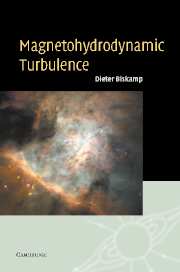Book contents
- Frontmatter
- Contents
- Preface
- 1 Introduction
- 2 Magnetohydrodynamics
- 3 Transition to turbulence
- 4 Macroscopic turbulence theory
- 5 Spectral properties and phenomenology
- 6 Two-point-closure theory
- 7 Intermittency
- 8 Two-dimensional turbulence
- 9 Compressible turbulence and turbulent convection
- 10 Turbulence in the solar wind
- 11 Turbulence in accretion disks
- 12 Interstellar turbulence
- Outlook
- References
- Index
6 - Two-point-closure theory
Published online by Cambridge University Press: 17 August 2009
- Frontmatter
- Contents
- Preface
- 1 Introduction
- 2 Magnetohydrodynamics
- 3 Transition to turbulence
- 4 Macroscopic turbulence theory
- 5 Spectral properties and phenomenology
- 6 Two-point-closure theory
- 7 Intermittency
- 8 Two-dimensional turbulence
- 9 Compressible turbulence and turbulent convection
- 10 Turbulence in the solar wind
- 11 Turbulence in accretion disks
- 12 Interstellar turbulence
- Outlook
- References
- Index
Summary
In the derivation of spectral laws presented in Chapter 5 we used only certain general properties of the turbulence, in particular the integral invariants, which lead to the spectral cascades. (Only the Alfvén effect resulting in the IK spectrum is based on a specific dynamic process of the MHD system.) Though phenomenological arguments, especially dimensional analysis, are often very powerful and robust, since they represent basic physical principles, they only predict a few scaling laws but cannot, for instance, specify proportionality factors, such as the Kolmogorov constant and the sign of the residual energy spectrum. Morover, these arguments provide little insight into the turbulence dynamics. Such properties must be treated by a statistical theory derived from the basic fluid equations. Here the most practical approach is two-point closure theory. An alternative method, renormalization-group (RNG) theory, which was originally developed in the context of the theory of critical phenomena, has also been applied to hydrodynamic turbulence (e.g., Yakhot and Orszag, 1986) and MHD turbulence (Fournier et al., 1982; Camargo and Tasso, 1992), but there is still a considerable degree of arbitrariness and even inconsistency. We shall therefore not discuss RNG theory any further but restrict the treatment in this chapter to closure theory.
In Chapter 4 we introduced the one-point-closure approximation consisting of the equations for the average fields and some phenomenological expressions for the correlation functions appearing in these equations, which is appropriate for describing large-scale inhomogeneous-turbulence processes. To study intrinsic small-scale properties, for which correlation functions are of primary interest, one has to go one step further in the hierarchy of moment equations.
- Type
- Chapter
- Information
- Magnetohydrodynamic Turbulence , pp. 113 - 130Publisher: Cambridge University PressPrint publication year: 2003



